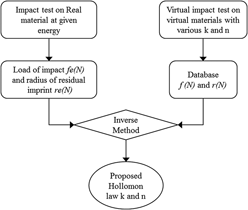Crossref Citations
This article has been cited by the following publications. This list is generated based on data provided by
Crossref.
Tumbajoy-Spinel, David
Descartes, Sylvie
Bergheau, Jean-Michel
Lacaille, Victor
Guillonneau, Gaylord
Michler, Johann
and
Kermouche, Guillaume
2016.
Assessment of mechanical property gradients after impact-based surface treatment: application to pure α-iron.
Materials Science and Engineering: A,
Vol. 667,
Issue. ,
p.
189.
Verma, Devendra
Exner, Matthias
and
Tomar, Vikas
2016.
An investigation into strain rate dependent constitutive properties of a sandwiched epoxy interface.
Materials & Design,
Vol. 112,
Issue. ,
p.
345.
Tumbajoy-Spinel, David
Descartes, Sylvie
Bergheau, Jean-Michel
Al-Baida, Halim
Langlade, Cécile
and
Kermouche, Guillaume
2017.
Investigation of graded strengthened hyper-deformed surfaces by impact treatment: micro-percussion testing.
IOP Conference Series: Materials Science and Engineering,
Vol. 194,
Issue. ,
p.
012024.
Tumbajoy-Spinel, David
Maeder, Xavier
Guillonneau, Gaylord
Sao-Joao, Sergio
Descartes, Sylvie
Bergheau, Jean-Michel
Langlade, Cécile
Michler, Johann
and
Kermouche, Guillaume
2018.
Microstructural and micromechanical investigations of surface strengthening mechanisms induced by repeated impacts on pure iron.
Materials & Design,
Vol. 147,
Issue. ,
p.
56.
Prakash, Chandra
Gunduz, I Emre
and
Tomar, Vikas
2019.
The effect of interface shock viscosity on the strain rate induced temperature rise in an energetic material analyzed using the cohesive finite element method.
Modelling and Simulation in Materials Science and Engineering,
Vol. 27,
Issue. 6,
p.
065008.
Prakash, Chandra
Gunduz, I Emre
and
Tomar, Vikas
2019.
Simulation guided experimental interface shock viscosity measurement in an energetic material.
Modelling and Simulation in Materials Science and Engineering,
Vol. 27,
Issue. 8,
p.
085003.
Prakasam, Mythili
Morvan, Adrien
Azina, Clio
Constantin, Loïc
Goglio, Graziella
Largeteau, Alain
Bordère, Sylvie
Heintz, Jean-Marc
Lu, Yongfeng
and
Silvain, Jean-François
2020.
Ultra-low temperature fabrication of copper carbon fibre composites by hydrothermal sintering for heat sinks with enhanced thermal efficiency.
Composites Part A: Applied Science and Manufacturing,
Vol. 133,
Issue. ,
p.
105858.
Breumier, Simon
Trudeau‐Lalonde, Francis
Lafrance, Thierry
Robert, Etienne
Villani, Aurélien
Kermouche, Guillaume
and
Lévesque, Martin
2021.
Controlled single and repeated impact testing for material plastic behaviour characterisation under high strain rates.
Strain,
Vol. 57,
Issue. 6,
Afshari, S. Saraygord
Pourtakdoust, Seid H.
Crawford, B.J.
Seethaler, R.
and
Milani, A.S.
2021.
Time-varying structural reliability assessment method: Application to fiber reinforced composites under repeated impact loading.
Composite Structures,
Vol. 261,
Issue. ,
p.
113287.
Hoc, Nguyen Quang
Trong, Dung Nguyen
Cuong, Nguyen Chinh
Tinh, Bui Duc
Hien, Nguyen Duc
Long, Van Cao
Saraç, Umut
and
Ţălu, Ştefan
2022.
Determination of Young Modulus and Stress-Strain Curve for Metal Fe and Interstitial Alloy FeC.
Journal of Composites Science,
Vol. 6,
Issue. 9,
p.
250.
Salama, Mariana C
Alves, Frederico PD
Reis, Luis
Deus, Augusto M
Silva, M Beatriz
Santos, Catarina
Carmezim, M Joao
and
Fátima Vaz, M
2023.
Finite element simulations of mechanical behaviour and degradation of iron lattices.
Proceedings of the Institution of Mechanical Engineers, Part L: Journal of Materials: Design and Applications,
Vol. 237,
Issue. 6,
p.
1379.
Wang, Kai
Ma, Qiantao
Xu, Jingmang
Liao, Tao
Wang, Ping
Chen, Rong
Kan, Qianhua
Cui, Guodong
and
Li, Lu
2023.
Determining the elastic–plastic properties of materials with residual stress included using nanoindentation experiments and dimensionless functions.
Engineering Fracture Mechanics,
Vol. 282,
Issue. ,
p.
109175.
Frutos, J.A.
Ambriz, R.R.
García, Ch. J.
and
Jaramillo, D.
2023.
Orthogonal impact load in 6061-T651 and 7075-T651 aluminum alloy plates.
Journal of Materials Research and Technology,
Vol. 26,
Issue. ,
p.
4245.
Salama, MC
Alves, F
Reis, L
Deus, AM
Silva, MB
Santos, C
Carmezim, MJ
and
Vaz, MF
2024.
Mechanical and corrosion performance of biodegradable iron porous structures.
Proceedings of the Institution of Mechanical Engineers, Part L: Journal of Materials: Design and Applications,
Vol. 238,
Issue. 1,
p.
204.
Levadnyi, Ievgen
Liu, Fujia
and
Gu, Yaodong
2024.
Identification of material parameters at high strain rates using ballistic impact tests and inverse finite element analysis.
AIP Advances,
Vol. 14,
Issue. 4,
Sohail, Hamza
Hamza, Amir
Rashid, Nasir
Ali, Muhammad Saad
Ghani, Taha
and
Jafry, A.T.
2024.
Optimization of Impact Resistant Throwable Unmanned Ground Vehicle Using Mathematical Modeling Techniques.
MATEC Web of Conferences,
Vol. 398,
Issue. ,
p.
01013.
